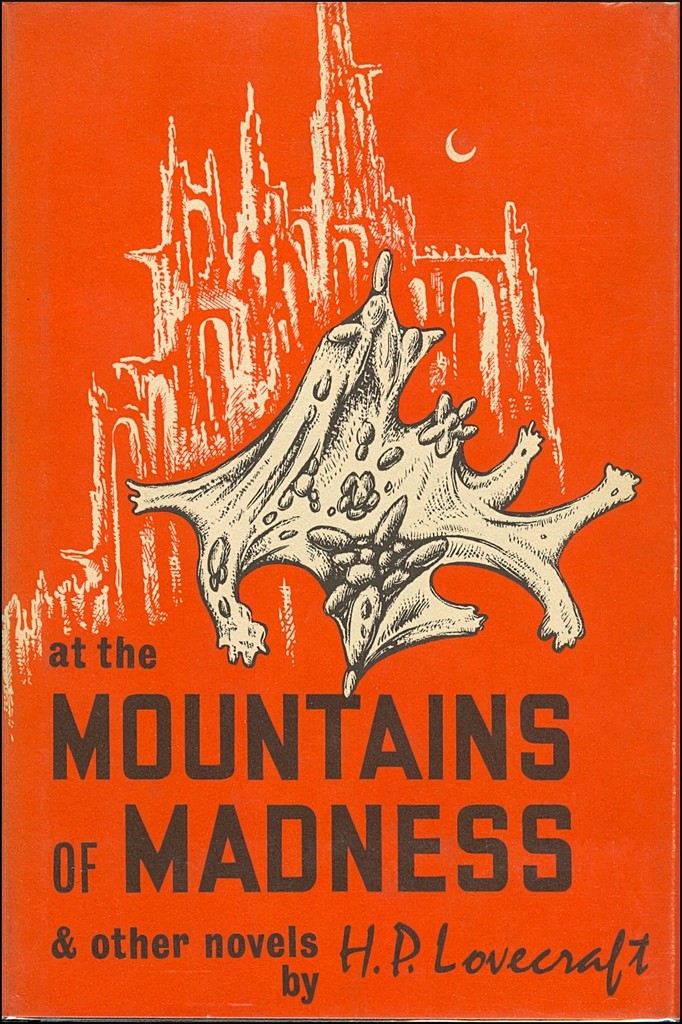At the Mountains of Madness (1936)

…………………………………………………
At the Mountains of Madness Book Review
At the Mountains of Madness is a 1936 science fiction horror novella by H. P. Lovecraft. It’s a highly influential and memorable, but ultimately less effective book in its own terms.
………………………………………………….
“I could not help feeling that they were evil things –
mountains of madness whose farther slopes looked out
over some accursed ultimate abyss“
…………………………………………………..

…………………………………………………..
The story details the events of a disastrous expedition to the Antarctic continent on September 1930, and what was found there by a group of explorers led by the narrator Dr. William Dyer. Throughout the story, Dyer details a series of previously untold events in the hope of deterring another group of explorers who wish to return to the continent.
This is undoubtedly a very intriguing storyline that remains iconic and actually impressively influential on many major science fiction horror movies, particularly ‘Alien’ and ‘The Thing’. Those famous classics definitely owe a lot to this story that started it all. Here we have the idea of ancient astronauts, the Earthly creators and ancient alien civilizations. ‘Prometheus’ for sure came a lot to my mind while reading this novella.
And I did love this entire story overall and especially some of those parts where the aforementioned happened. I actually loved the build-up to the story even more as it’s beautifully written and I adored his evident knowledge of archaeology and evolutionary history of animals and plants which is one of my areas of interest so of course I loved reading through those.
…………………………………………………..

…………………………………………………..
So in the end why was I disappointed in this literary work when it has all of those immense and very obvious strengths? Well, first off, the characterization is immensely weak, even for the lesser expectations of this genre overall when it comes to character development. But even though I liked the central narration and the protagonist, otherwise most of them are as thin as paper and hugely forgettable.
But the biggest problem here is what I would call the author’s unwillingness to make the book universally readable for all readers as this is, at least to me, exceedingly difficult to read or understand even at times. The writing style of H. P. Lovecraft is problematic. I have a big respect for him for making this story as the overall idea is awesome and also the descriptive passages are superb as the book’s atmosphere is undeniably superbly conveyed, but he just did not make this fun or engaging enough to read.
There is a lot of dry writing here to the point of the book being quite boring at times, especially in its middle chapters. I also found it not particularly well conveyed in the most important plot points and I had to read afterwards what happened because it wasn’t explained well enough for me.
The imagery in At the Mountains of Madness is impressive, there is no denying that. The Antarctic continent is beautifully utilized, the atmosphere is chilling and creepy, but the horror elements needed to have been stronger as the book isn’t particularly scary, though some of the imagery does leave an impact.
…………………………………………………..

…………………………………………………..
So I did love the descriptions of the things they encountered and those were the best parts, but the descriptions of the emotions and major plot developments did not work nearly as well. I appreciate how ahead of his time Lovecraft was in his ideas and the mixture of science fiction and horror elements, but in the writing itself he’s of his time too much, the same as Olaf Stapleton was in ‘Star Maker’. I share pretty much similar opinion about these two.
In the end, At the Mountains of Madness is a fascinating read. Though difficult to understand at times and honestly quite boring in some parts, the book is beautifully written in its descriptions, very atmospheric and well utilized in its location, memorable in imagery and highly influential in its original ideas and mixture of SF and horror elements.







